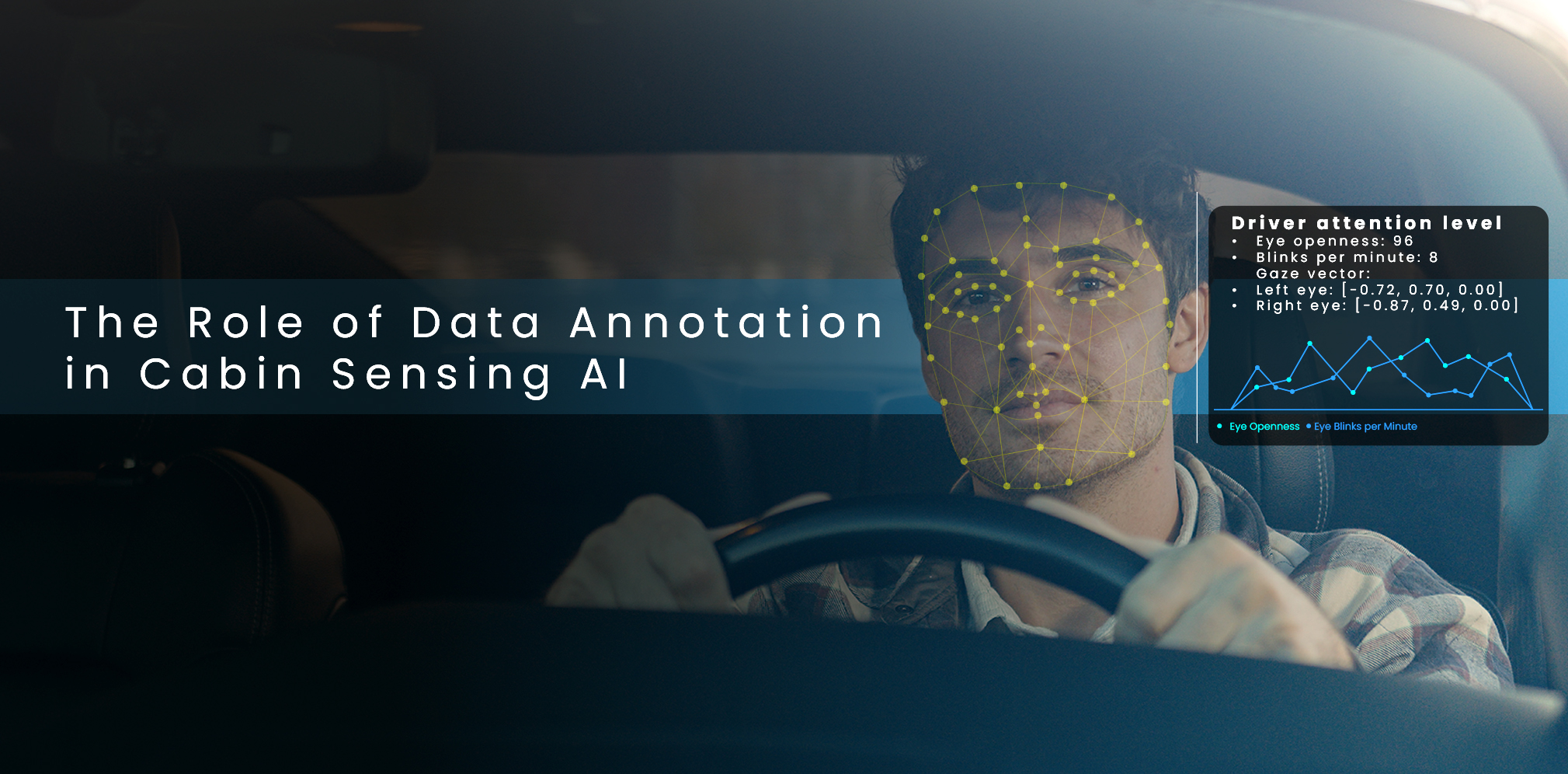Quick Overview
This blog showcases how data annotation drives the future of safer and smarter cabin sensing systems. With NextWealth’s Human-in-the-Loop (HITL) approach, you’ll discover how high-quality, accurate data enhances driver and passenger safety. Gain insights into how precise annotation helps create personalized, reliable, and compliance-ready AI solutions.
Key points include:
- The significance of precise data annotation for training cabin sensing AI systems.
- How annotated data supports driver and passenger monitoring, including fatigue and distraction detection.
- The challenges of annotating complex human behaviors, sensor limitations, and context dependency.
- Why Human-in-the-Loop (HITL) annotation ensures higher accuracy and regulatory compliance.
- The future of cabin sensing systems is driven by regulatory mandates and technological innovation.
Introduction: The next frontier of vehicle safety lies not outside the windshield, but within the cabin itself…
The automotive industry is at an inflection point. While autonomous driving dominates headlines, a quieter transformation is happening inside vehicles: the rapid evolution of cabin sensing systems. These AI-powered technologies monitor drivers and passengers in real time, enabling advanced safety features, personalized comfort, and even health-related interventions.
Cabin sensing relies on multiple sensor modalities like infrared cameras, RGB cameras, radar, microphones, and depth sensors to continuously capture in-cabin activity. AI then interprets this data to make safety-critical decisions such as alerting a drowsy driver, detecting passenger occupancy, or adjusting settings to improve comfort.
But AI can only be as effective as the data it is trained on. That raw sensor data must be carefully annotated & labelled with precision & context to help models understand the complex realities of human behaviour. This is where NextWealth plays a pivotal role, using its Human-in-the-Loop (HITL) methodology to ensure cabin sensing systems are trained on high-quality, regulation-ready datasets.
Why Data Annotation Is the Cornerstone of Cabin Sensing AI
Annotation is the process of labelling raw images, video frames, or sensor signals so AI can recognize and respond to patterns. In cabin sensing, accurate annotation directly enables:
- Driver monitoring: Labelled facial landmarks, gaze direction, and head positions help AI detect fatigue, distraction, or drowsiness.
- Occupant behaviour recognition: Gestures, postures, and seat interactions can be annotated to help systems respond to passenger needs.
- Health and wellness monitoring: Annotated micro-expressions, breathing patterns, or irregular movement can signal medical emergencies.
- Personalized experiences: Annotated gestures and expressions support adaptive systems that adjust lighting, seat position, or infotainment in real time.
High-quality annotated data ensures cabin sensing models can distinguish nuanced behaviours for example, between a driver glancing at a side mirror versus checking a mobile phone. Without accurate annotation, the risk of false positives or false negatives increases, undermining safety.
In this sense, data annotation is not a backend task—it is the foundation of intelligent, safe, and personalized cabin AI systems.
The High-Stakes Challenges of Data Annotation in Cabin AI
Unlike general-purpose computer vision, cabin sensing presents unique challenges:
- Human variability: People differ in posture, clothing, body type, and cultural behaviour. Annotations must capture this diversity to train inclusive AI systems.
- Sensor limitations: Low-light conditions, occlusions (from masks, sunglasses, or hands), and camera placement issues complicate labelling.
- Context dependency: A downward head tilt may indicate either checking infotainment or falling asleep—annotation must incorporate context.
- Safety-critical demands: Errors in annotation can lead to unsafe models. For example, if fatigue is mislabelled, AI systems may fail to trigger alerts, risking accidents.
These challenges highlight why automated annotation alone is insufficient and why expert Human-in-the-Loop oversight is indispensable.
Beyond Automation: Why Cabin Sensing Needs Human-in-the-Loop
Human-in-the-Loop (HITL) annotation combines AI automation with expert human review to ensure precision in edge cases and safety-critical contexts.
Advantages of HITL in cabin sensing include:
- Handling rare events: Medical emergencies, occluded passengers, or unusual gestures can only be reliably annotated with human judgment.
- Contextual interpretation: Humans differentiate between superficially similar actions (e.g., resting head vs. fatigue), which AI often mislabels.
- Continuous improvement: Annotator feedback improves AI pipelines, creating a virtuous cycle of model enhancement.
- Scale + precision: AI pre-labelling accelerates large datasets, while human review ensures regulatory-grade accuracy.
At NextWealth, our HITL model ensures annotations are not only correct but also contextually relevant, producing datasets robust enough for deployment in high-stakes automotive environments.
From Mandate to Market: The Global Future of Cabin Sensing
Cabin sensing is being accelerated by both regulations and market forces.
- Regulatory Roadmap
- European Union (EU):
- From July 2024, the General Safety Regulation (GSR) requires Driver Drowsiness and Attention Warning (DDAW) systems in all new vehicles sold across the EU. The regulation will expand further, requiring Advanced Driver Distraction Warning (ADDW) using eye-tracking and head pose detection for new vehicle types in 2024, and for all vehicles by July 2026.
- United States (US):
- In January 2024, the National Highway Traffic Safety Administration (NHTSA) issued an Advance Notice of Proposed Rulemaking (ANPRM) on advanced impaired-driving prevention technologies, including alcohol detection and driver monitoring systems.
- Through 2024–2025, NHTSA has continued researching these technologies and soliciting public input.
- In August 2025, NHTSA opened a public comment period on Driver Monitoring Systems (DMS) in SAE Level 2 vehicles, signalling the move toward formal rulemaking
- Additionally, in June 2025, NHTSA amended its Standing General Order to update reporting for advanced systems and crashes
- Summary:
- EU: Cabin sensing is mandatory since 2024.
- US: Draft regulations and adoption are accelerating in 2024–2025, with OEMs preparing vehicles ahead of mandates.
- Market Adoption Trends
- OEM rollouts: By 2025, cabin sensing is becoming standard in mid-range and premium vehicles, not just luxury models.
- Biometric Monitoring: Automakers are introducing stress, fatigue, and wellness detection features into production vehicles.
- Emotion-aware Personalization: Adaptive systems adjust lighting, seat comfort, and infotainment based on mood detection.
- Fleet Adoption: Logistics operators in the US are adopting cabin sensing to reduce fatigue-related crashes and benefit from insurance incentives
- Market Growth: The global cabin monitoring system market was valued at $8 billion in 2024 and is projected to exceed $37 billion by 2034, growing at a CAGR of 16.5%.
- Technology Innovation: Tesla and other OEMs are deploying in-cabin radar and 3D cameras in 2025 for more reliable detection.
- Biometric Authentication: New features like iris and face-based authentication are emerging, enabled by existing in-cabin cameras
These trends highlight how accurate annotation remains the foundation for both compliance and innovation in cabin sensing.
NextWealth’s Approach to Data Annotation in Cabin Sensing Systems
At NextWealth, our methodology blends scale, quality, and adaptability:
- AI-assisted annotation automates repetitive tasks.
- Expert human review (HITL) ensures contextual accuracy for edge cases.
- Rigorous QA consistently achieves 98%+ precision and recall.
- Scalable delivery enables annotation of millions of frames daily for global clients.
Our annotators are trained to label complex behaviours, including:
- Micro-sleeps and prolonged eye closure.
- Distracted driving gestures such as phone use, eating, or reaching.
- Multi-occupant dynamics and occlusions.
- Subtle signs of stress, fatigue, or medical distress.
This process-centric, quality-first approach makes NextWealth a trusted partner for OEMs, Tier-1 suppliers, and automotive innovators worldwide.
Case Study: Delivering Regulatory-Grade Cabin Sensing Annotation at Scale
- The Challenge..
A Tier-1 Automotive Software Provider, needed large-scale, regulation-ready annotation for cabin sensing datasets. Their goals included:
- Handling complex facial expressions in varying conditions.
- Annotating fatigue and distraction events with contextual accuracy.
- Meeting EU’s 2024 GSR standards while preparing for US 2025 regulations.
- The NextWealth Solution..
We implemented our HITL-driven annotation pipeline, combining automation with human oversight. Annotators received specialized training in cabin sensing behaviours and followed a multi-stage QA process.
- The Impact..
- Achieved 98%+ annotation accuracy, exceeding quality thresholds.
- Processed tens of thousands of frames daily without sacrificing precision.
- Enabled clients AI models to significantly improve detection of distraction and fatigue, ensuring compliance and readiness for global rollouts.
This case illustrates how NextWealth enables clients to stay ahead of both regulation and market adoption curves.
Conclusion: Why Smarter, Safer Cabins Begin with Better Data..
Cabin sensing has shifted from a futuristic concept to an industry mandate. With EU regulations already in effect since 2024 and US adoption accelerating in 2025, the ability to monitor drivers and passengers is now a baseline expectation for compliance and consumer trust.
At the centre of this transformation is not just AI or sensors, it is data annotation. Without precisely labelled, context-rich datasets, cabin sensing systems cannot reliably distinguish between a tired glance and a distracted one, or between a relaxed passenger and someone in distress.
This is where NextWealth makes the difference. Our Human-in-the-Loop approach ensures annotation is not only accurate, but also contextually intelligent and scalable. By combining automation with human expertise, we deliver the regulatory-grade data that makes cabin sensing systems safe, trustworthy, and ready for global deployment.
Our track record in helping leading automotive software providers achieve 98%+ annotation accuracy at scale demonstrates that smarter, safer cabins always begin with better data.
Final Call to Action:
If you’re building the future of cabin sensing, partner with NextWealth. Together, we’ll ensure your AI systems are trained on the kind of data that regulators trust, automakers demand, and passengers deserve.
References….
- EU General Safety Regulation (GSR) – DDAW mandatory from July 2024, ADDW phased in by 2026: European Commission, Smart Eye.
- NHTSA ANPRM on impaired-driving prevention (Jan 2024): Federal Register.
- NHTSA reports 2024–2025: Transportation.gov.
- NHTSA DMS public comment (Aug 2025): Federal Register.
- NHTSA Standing General Order update (June 2025): NHTSA.
- Market growth of cabin monitoring ($8B in 2024 → $37B by 2034): Global Market Insights.
- Tesla & OEM in-cabin radar adoption (2025): Edge AI Vision.
- CES 2025 in-cabin sensing trends: Digital Dealer.
- Biometric in-cabin authentication (2025): Biometric Update.
Automotive camera module growth (2024–2030): Optics.org.

